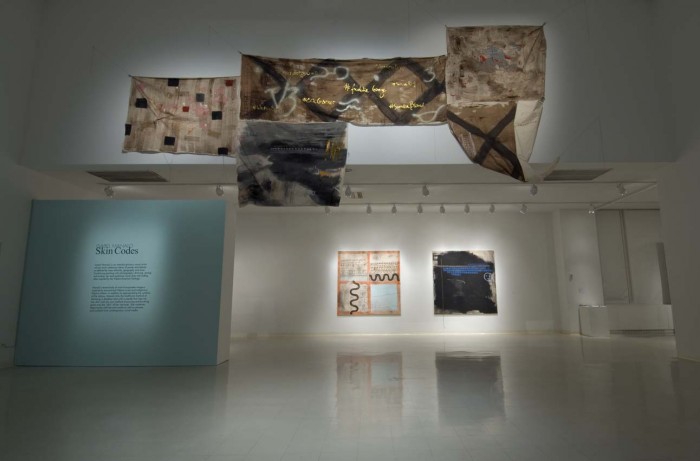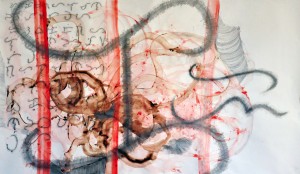ACES: “Skin Codes”
Posted December 7, 2015 
By Chanika Svetvilas
SKIN CODES
Paul W. Zuccaire Gallery, Stony Brook University
Isabel Manalo: Skin Codes, ongoing to December 12, 2015
“What do potent issues like the Black Lives Matter movement, Syria, and climate change have in common? They have all trended on social media widely as hot topics and they have surfaced in Isabel Manlo’s paintings that are currently on view in a solo exhibition at Paul W. Zuccaire Gallery at Staller Center for the Arts, Stony Brook University entitled Skin Codes that was created primarily during her residency in Berlin. When walking into the cavernous white gallery space, one immediately notices the rhythm of the large patterned earth toned paintings that punctuate the space.
In the acrylic paintings on canvas in the first half of the gallery, Manalo, a second generation Filipina American, conflates indigenous Filipino tattooing, pre-colonial Filipino Baybayin script, emojis and personal motifs with trending topics that one might expect to be a delicate balance to navigate without being seen as simply co-opting cases or trivializing the issues. Manalo though eloquently merges what she calls coding or modern day hieroglyphics to create a hybrid language that draws our attention to look deeper into these juxtapositions. In the accompanying exhibition catalogue, she calls it tweeting on canvas as markers in history.”
 Photo Credit: Maxine Hicks
Photo Credit: Maxine Hicks“The second half of the gallery is devoted to Manalo’s transitional work as she explored the paper as skin, use of thread as mark and collage with fabric and photography. Here you can see process at work in Katotohanan (The Truth). The fluidity of the red paint evokes blood smeared between glass slides as palm trees pop out. The eye follows the amorphous shapes of mylar layers on paper that echo the wash of paint and graphite marks to threaded red loops that lead to a dangling cutout. We also have a glimpse into Manalo’s process in a wall of small sketches in Stitched Baybayin.”
 Isang Araw (One Day), 2014
Isang Araw (One Day), 2014“Very often the focus is post-colonial and immigrant history and we forget the stories
that came before the colonization and immigrant arrival to the United States. Additionally,
with fleeting likes and tweets what happens to the stories that are no longer trending?
Manalo’s paintings makes visible Black lives, Syrian refugees, climate change, her
pre-colonial Filipina heritage, and memories into the permanence of her paintings
in this internal call and response between what’s trending and what do we really know.
The coding becomes a secret language that protects as it honors.”
